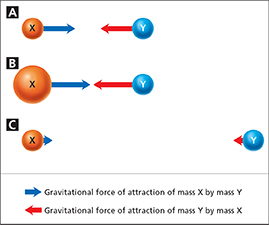Quick Lab
Investigating Force and Distance
Materials
balloon, bubble solution, bubble wand
Procedure 
Inflate a balloon and then make a knot in its neck to close it. Rub the balloon back and forth against your hair to charge it.
Blow several bubbles into the air and hold the charged balloon above them. Observe how the distance between the balloon and the bubbles affects the speed at which the bubbles fall. CAUTION Quickly wipe up any spilled bubble solution to avoid slips and falls.
Try to temporarily suspend a bubble in the air without touching it with the balloon.
Analyze and Conclude
Drawing Conclusions How does the distance between two objects affect the force of attraction between them?
Predicting If a bubble were suspended below the balloon, what do you think would happen when you moved the balloon closer to the bubble?
Weak Nuclear Force
The other powerful force in the nucleus is the weak nuclear force. As the name implies, the weak force is weaker in strength than the strong nuclear force. The weak nuclear force is an attractive force that acts only over a short range. The short range over which the weak nuclear force acts, about 10-18 meters, is less than the range of the strong nuclear force.
Gravitational Force
Gravity, the weakest universal force, is so much a part of your life that you probably take it for granted. You know from experience that objects fall toward Earth. It was Newton who discovered that gravity affects all objects in the universe. The same force acting on a falling apple is also acting on the moon to keep it in its orbit.
Gravitational force involves much more than just Earth's gravitational field. Gravitational force is an attractive force that acts between any two masses.  Newton's law of universal gravitation states that every object in the universe attracts every other object.
Newton's law of universal gravitation states that every object in the universe attracts every other object.
Thus, Earth exerts a force on an apple, and the apple exerts an equal force on Earth. You exert a gravitational force on your textbook, and your textbook exerts an equal gravitational force on you. The reason you don't notice gravity pulling your textbook toward you is that your mass and the mass of the textbook are so small. It takes a huge mass such as Earth's to exert a large gravitational force. The attractive force of gravity acting between two objects is shown in Figure 21.

Figure 21 Gravitational force depends upon mass and distance. A Two masses, X and Y, attract each other. B The larger mass of X results in a larger gravitational force. C Increasing the distance between the masses significantly reduces the gravitational force.




